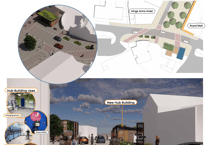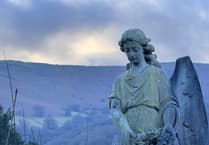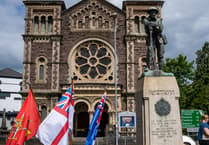DESPITE being hit by an earthquake earlier this year, Abergavenny has thankfully never been prone to natural disasters.
The tsunamis, landslides, hurricanes, forest fires, flash floods and snow storms of more extreme environments have for the most part given old mother Aber a rain-check.
Way back in 1907 the Abergavenny Chronicle reported, “Abergavenny and neighbourhood were visited this week by thunder storms accompanied by a deluge of rain and a fall of hail exceeding in violence anything within the memory of anyone living in the district.
Thunder of the heaviest and lightning of the most vivid prevailed. So heavy was the fall that branches of ash and other trees were not only entirely denuded of their foliage, but the bark stripped off in places by the sharp edges of the lumps of ice some three inches long and one in diameter.
The corn was broken down together with the thistles, as though beaten with a flail.
Cattle and poultry were killed, and a large mass of water running down the sides of the Black Mountains into the Vale of Llanthony caused large landslides.”
Now that certainly sounds like a storm straight out of Hollywood disaster movie, possibly starring Brad Pitt. Yet despite that little watery interlude and elemental concern, things trickled along quite nicely in the Gateway to Wales, until the year of our lord 1931, and what has come to be known in Abergavenny lore as the Great Mill Street flood.
It happened on a Wednesday night in May. A terrible storm broke across South Wales just after 9.30pm and ravaged the area with a ferocity which didn’t ease until midnight.
Like a plague from the Old Testament, forked lightning, rolling thunder, and torrential rain battered Abergavenny into meek submission.
The downpour was incessant and as it pounded its mocking rhythm on the town’s streets, meadows, hills, and rivers, the gentle and meandering Gavenny rose like a venomous snake and burst its banks.
A deluge of water swept across Swan Meadows and cascaded into Mill Street like a battering ram.
The force of the water smashed through windows and tore down doors as the lazy old stream was transformed into a raging torrent.
“It was like a sea,” revealed one eye-witness, as the great rush of water caught everyone unawares. The flood was said to have broke across the Monmouth Road like the bursting of a dam. All the residents could do was flee upstairs. In next to no time the lower levels of their homes were completely submerged and the bedrooms were filled with two foot of water. Some reportedly punched holes in the ceiling and climbed upon their roofs for safety.
The great flood left a trail of destruction in its wake.
The Chronicle reported in the aftermath, “No-one could visit Mill Street without being moved by the pathetic and heart-rending scene which presented itself to the gaze of crowds and people who flocked to the spot. Ruin and desolation were everywhere, but though the tenants of these humble abodes saw their homes wrecked in a night, they, with wonderful fortitude, tried to make the best of matters. It was a sight for tears to see them rescuing from the wreck and cleaning their little household possessions and trying among the hopeless tangle to put their houses in to something like ship-shape order. Everyone marvellled at the spirit of the people in Mill Street and their stoical clam and philosophy in the face of such a calamity.”
The road bridge across the Gavenny, Pen-y-Fal’s gas mains, and No.1 Asylum Terrace in Monk Street were also washed away in the flood. One of the houses worst hit was No. 3, Court B, Mill Street.
A Chronicle reporter visited the home of Mr Poulson and his family and wrote, “In the bedroom I was shown a hole in the ceiling which had been broken in a desperate bid to get on to the comparative safety of the roof. Mr and Mrs Poulson, 16-year-old son Tom, and 11-year-old daughter Doris clambered through followed by their dog, and here they remained until the danger was past. Two cats were imprisoned in the bedroom, but they jumped up on the dressing table and stayed there until it was safe for them to come down.”
Mr Poulson told the Chronicle, “I have seen many floods but I have never experienced anything like this. We were caught like rats in a trap. When I saw the wall by the garage go crashing down and saw the flood of water rushing at us, I thought, ‘O God, it is all over.’ We broke a hole through the roof and we stayed there during the early hours. It looked as if it was all up, and my little boy said, ‘We will all go together.’”
The whole of Abergavenny police force were mobilized and went rushing to Mill Street with an army of volunteers. It’s reported that, “Many heroic deeds were preformed which it is impossible to catalogue.”
Superintendent Thomas explained, “It was a herculean task battling with the flood in an endeavor to help the unfortunate people who were surrounded on all sides. It was also a desperately dangerous undertaking and a wonder that all the people were not drowned.”
Sadly, in amongst the narrow escapes, one person did lose their life in the flood. Mrs Vaughan, a widow who lived at 45 Mill Street. P.C. Hughes was attempting to help her though the bedroom window of her house which was in danger of collapsing, when a strong current swept her from his arms and to her death.
Alongside Mill Street, businesses in Frogmore Street, Queen Street, King Street and other parts of Abergavenny were seriously flooded.
The cellars of the Old Herefordshire House were flooded up to the ceiling and barrels were floating level with the trap door.
The Swan, The White Horse, Britannia Inn, and the Butchers Arms were also flooded. The force of the flood also flattened out many of the gravestones at Lantilio Pertholey Churchyard.
It’s safe to say the great flood of 1931 left a trail of scars in its wake. It took over a year for the local council to obtain funds from the Government to commence the rebuilding of roads, pavements and boundary walls.
In July 1932, the owners of the Swan Hotel had become so wary of another flood they made the decision to raise the ground floor to the height of the window sills. Hence the steep steps at the entrance.
Fortunately, Abergavenny has not been subject to a natural disaster on this scale since.
As for the Gavenny, it still charts a peaceful and winding course through Abergavenny to merge with the might of the Usk. And just perhaps the babbling brook still carries a lazy memory on its cool currents of the night it unleashed its full fury and flooded a town.




